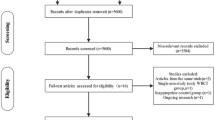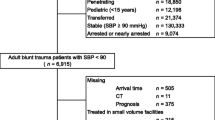Abstract
Background
Whole-body computed tomography (WBCT) is increasingly being incorporated into the initial management of blunt trauma patients. Several observational studies have suggested that, compared to selective CT, WBCT is associated with lower mortality. In contrast, a randomized controlled trial found no significant difference in survival between patients undergoing WBCT compared to selective CT. Our objective was to confirm the association between WBCT and in-hospital mortality among adult severe blunt trauma patients.
Methods
This was a retrospective cohort study based on Japan Trauma Data Bank 2004–2015 registry data. The study population comprised adult severe blunt trauma patients with at least one abnormal vital sign: systolic blood pressure ≤100 mmHg, heart rate ≥120, respiratory rate ≥30 or ≤10, or Glasgow Coma Score ≤13. The primary outcome was in-hospital mortality. To adjust for both measured and unmeasured confounders, we performed instrumental variable (IV) analysis to compare the in-hospital mortality of patients undergoing WBCT with those undergoing selective CT.
Results
Of 40,435 patients who were eligible for this study, 19,766 (48.9%) patients underwent WBCT. The proportion of patients undergoing WBCT significantly increased during the study period, from 10.7% in 2004 to 59.6% in 2015. Primary IV analysis showed a significant association between WBCT and lower in-hospital mortality (odds ratio 0.84, 95% confidence interval 0.72–0.98).
Conclusions
WBCT can be beneficial in patients with blunt trauma which has compromised vital signs. These findings from a nationwide study suggest that physicians should consider WBCT for blunt trauma patients when warranted by vital signs.



Similar content being viewed by others
References
Long B, April MD, Summers S et al (2017) Whole body CT versus selective radiological imaging strategy in trauma: an evidence-based clinical review. Am J Emerg Med 35:1356–1362
Weninger P, Mauritz W, Fridrich P et al (2007) Emergency room management of patients with blunt major trauma: evaluation of the multislice computed tomography protocol exemplified by an urban trauma center. J Trauma 62:584–591
Kanz KG, Paul AO, Lefering R et al (2010) Trauma management incorporating focused assessment with computed tomography in trauma (FACTT)—potential effect on survival. J Trauma Manag Outcomes 4:4
Wurmb TE, Frühwald P, Hopfner W et al (2009) Whole-body multislice computed tomography as the first line diagnostic tool in patients with multiple injuries: the focus on time. J Trauma 66:658–665
Gupta M, Schriger DL, Hiatt JR et al (2011) Selective use of computed tomography compared with routine whole body imaging in patients with blunt trauma. Ann Emerg Med 58:407–416
Brenner DJ, Elliston CD (2004) Estimated radiation risks potentially associated with full-body CT screening. Radiology 232:735–738
Stengel D, Frank M, Matthes G et al (2009) Primary pan-computed tomography for blunt multiple trauma: can the whole be better than its parts? Injury 40:S36–S46
Snyder GE (2008) Whole-body imaging in blunt multisystem trauma patients who were never examined. Ann Emerg Med 52:101–103
Gordic S, Alkadhi H, Hodel S et al (2015) Whole-body CT-based imaging algorithm for multiple trauma patients: radiation dose and time to diagnosis. Br J Radiol 88:20140616
Linder F, Mani K, Juhlin C et al (2016) Routine whole body CT of high energy trauma patients leads to excessive radiation exposure. Scand J Trauma Resusc Emerg Med 24:7
Huber-Wagner S, Lefering R, Qvick LM et al (2009) Effect of whole-body CT during trauma resuscitation on survival: a retrospective, multicentre study. Lancet 373:1455–1461
Huber-Wagner S, Biberthaler P, Haeberle S et al (2013) Whole-body CT in haemodynamically unstable severely injured patients—a retrospective, multicentre study. PLoS One 8:e68880
Wada D, Nakamori Y, Yamakawa K et al (2013) Impact on survival of whole-body computed tomography before emergency bleeding control in patients with severe blunt trauma. Crit Care 17:R178
Kimura A, Tanaka N (2013) Whole-body computed tomography is associated with decreased mortality in blunt trauma patients with moderate-to-severe consciousness disturbance: a multicenter, retrospective study. J Trauma Acute Care Surg 75:202–206
Yeguiayan JM, Yap A, Freysz M et al (2012) Impact of whole-body computed tomography on mortality and surgical management of severe blunt trauma. Crit Care 16:R101
Caputo ND, Stahmer C, Lim G et al (2014) Whole-body computed tomographic scanning leads to better survival as opposed to selective scanning in trauma patients: a systematic review and meta-analysis. J Trauma Acute Care Surg 77:534–539
Jiang L, Ma Y, Jiang S et al (2014) Comparison of whole-body computed tomography vs selective radiological imaging on outcomes in major trauma patients: a meta-analysis. Scand J Trauma Resusc Emerg Med 22:54
Surendran A, Mori A, Varma DK et al (2014) Systematic review of the benefits and harms of whole-body computed tomography in the early management of multitrauma patients: are we getting the whole picture? J Trauma Acute Care Surg 76:1122–1130
Sierink JC, Treskes K, Edwards MJR et al (2016) Immediate total-body CT scanning versus conventional imaging and selective CT scanning in patients with severe trauma (REACT-2): a randomised controlled trial. Lancet 388:673–683
Wutzler S, Marzi I (2016) Routine total-body CT for trauma room patients—life saver or needless radiation exposure? J Thorac Dis 8:3040–3041
Sammy IA, Chatha H, Bouamra O et al (2017) The use of whole-body computed tomography in major trauma: variations in practice in UK trauma hospitals. Emerg Med J 34:647–652
Jiang L, Zhang M (2016) Who will benefit from whole-body computed tomography? Am J Emerg Med 34:1907–1908
Japan Trauma Care and Research. Japan Trauma Data Bank Report 2015 (2010–2014). https://www.jtcr-jatec.org/traumabank/dataroom/data/JTDB2015e.pdf Accessed 8 Oct 2017
Tohira H, Jacobs I, Mountain D et al (2012) International comparison of regional trauma registries. Injury 43:1924–1930
Tsuchiya A, Tsutsumi Y, Yasunaga H (2016) Outcomes after helicopter versus ground emergency medical services for major trauma—propensity score and instrumental variable analyses: a retrospective nationwide cohort study. Scand J Trauma Resusc Emerg Med 24:140
Davis N, Gunnell D, Thomas KH et al (2013) Physicians’ prescribing preferences were a potential instrument for patients’ actual prescriptions of antidepressants. J Clin Epidemiol 66:1386–1396
Haider AH, Saleem T, Leow JJ et al (2012) Influence of the national trauma data bank on the study of trauma outcomes: is it time to set research best practices to further enhance its impact? J Am Coll Surg 214:756–768
Ley EJ, Singer MB, Clond MA et al (2012) Admission heart rate is a predictor of mortality. J Trauma Acute Care Surg 72:943–947
Hondo K, Shiraishi A, Fujie S et al (2013) In-hospital trauma mortality has decreased in Japan possibly due to trauma education. J Am Coll Surg 217(850–857):e1
Vandenbroucke JP, von Elm E, Altman DG et al (2007) Strengthening the reporting of observational studies in epidemiology (STROBE): explanation and elaboration. Epidemiology 18:805–835
Cuzick JA (1985) Wilcoxon-type test for trend. Stat Med 4:87–90
Sierink JC, Treskes K, Dijkgraaf MGW et al (2017) The importance of immediate total-body CT scanning—authors’ reply. Lancet 389:503
Huber-Wagner S, Lefering R, Kanz KG et al (2017) The importance of immediate total-body CT scanning. Lancet 389:502–503
Andersohn F (2009) Effect on survival of whole-body CT during trauma resuscitation. Lancet 374:197
TraumaRegister DGU (2014) 20 years of trauma documentation in Germany—Actual trends and developments. Injury 45:S14–S19
Hutter M, Woltmann A, Hierholzer C et al (2011) Association between a single-pass whole-body computed tomography policy and survival after blunt major trauma: a retrospective cohort study. Scand J Trauma Resusc Emerg Med 19:73
Brenner DJ, Hall EJ (2007) Current concepts—computed tomography—an increasing source of radiation exposure. N Engl J Med 357:2277–2284
Treskes K, Saltzherr TP, Luitse JSK et al (2017) Indications for total-body computed tomography in blunt trauma patients: a systematic review. Eur J Trauma Emerg Surg 43:35–42
The Ministry of Health, Labour and Welfare. Kyumei-center no hyoka kekka [Annual evaluation of emergency and critical care centers]. The Ministry of Health, Labour and Welfare 2017. Japanese. http://www.mhlw.go.jp/file/06-Seisakujouhou-10800000-Iseikyoku/0000188903.pdf. Accessed 13 May 2018
Acknowledgements
We would like to thank all members and personnel of the JTDB, the Japanese Association for Trauma Surgery, the Japanese Association for Acute Medicine, and Japan Trauma Care and Research. We thank Libby Cone, MD, MA, and Guy Harris, DO from DMC Corp. (www.dmed.co.jp) for editing drafts and the revised version of this manuscript.
Author information
Authors and Affiliations
Corresponding author
Ethics declarations
Conflict of interest
The authors declare that they have no conflict of interest.
Electronic supplementary material
Below is the link to the electronic supplementary material.
268_2018_4732_MOESM3_ESM.pdf
Absolute standardized differences in measured confounders between IV and actual treatment. IV, instrumental variable; ISS, injury severity score (PDF 84 kb)
Rights and permissions
About this article
Cite this article
Tsutsumi, Y., Fukuma, S., Tsuchiya, A. et al. Whole-Body Computed Tomography During Initial Management and Mortality Among Adult Severe Blunt Trauma Patients: A Nationwide Cohort Study. World J Surg 42, 3939–3946 (2018). https://doi.org/10.1007/s00268-018-4732-5
Published:
Issue Date:
DOI: https://doi.org/10.1007/s00268-018-4732-5




